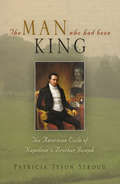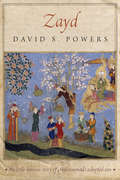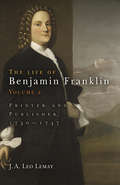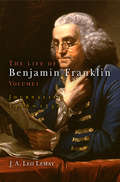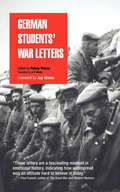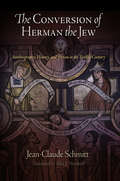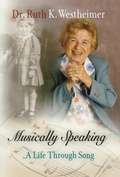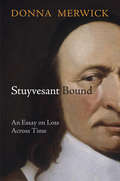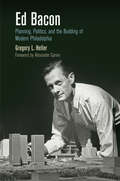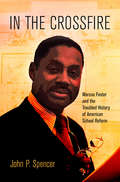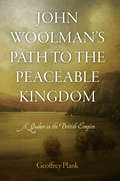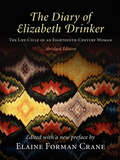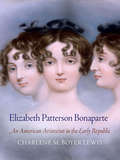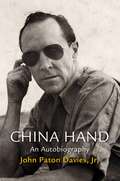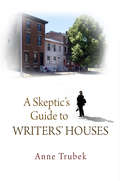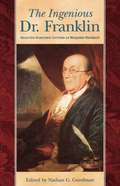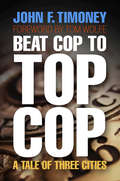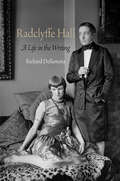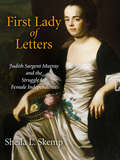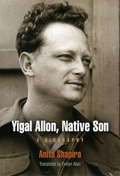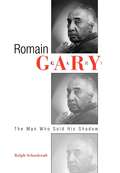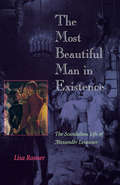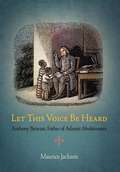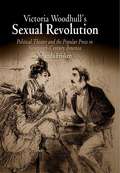- Table View
- List View
The Man Who Had Been King
by Patricia Tyson StroudJoseph Bonaparte, King of Naples and Spain, claimed that he had never wanted the overpowering roles thrust upon him by his illustrious younger brother Napoleon. Left to his own devices, he would probably have been a lawyer in his native Corsica, a country gentleman with leisure to read the great literature he treasured and oversee the maintenance of his property. When Napoleon's downfall forced Joseph into exile, he was able to become that country gentleman at last, but in a place he could scarcely have imagined.It comes as a surprise to most people that Joseph spent seventeen years in the United States following Napoleon's defeat at Waterloo. In The Man Who Had Been King, Patricia Tyson Stroud has written a rich account--drawing on unpublished Bonaparte family letters--of this American exile, much of it passed in regal splendor high above the banks of the Delaware River in New Jersey.Upon his escape from France in 1815, Joseph arrived in the new land with a fortune in hand and shortly embarked upon building and fitting out the magnificent New Jersey estate he called Point Breeze. The palatial house was filled with paintings and sculpture by such luminaries as David, Canova, Rubens, and Titian. The surrounding park extended to 1,800 acres of luxuriously landscaped gardens, with twelve miles of carriage roads, an artificial lake, and a network of subterranean tunnels that aroused much local speculation.Stroud recounts how Joseph became friend and host to many of the nation's wealthiest and most cultivated citizens, and how his art collection played a crucial role in transmitting high European taste to America. He never ceased longing for his homeland, however. Despite his republican airs, he never stopped styling himself as "the Count de Survilliers," a noble title he fabricated on his first flight from France in 1814, when Napoleon was exiled to Elba, nor did he ever learn more than rudimentary English. Although he would repeatedly plead with his wife to join him, he was not a faithful husband, and Stroud narrates his affairs with an American and a Frenchwoman, both of whom bore him children. Yet he continued to feel the separation from his two legitimate daughters keenly and never stopped plotting to ensure the dynastic survival of the Bonapartes.In the end, the man who had been king returned to Europe, where he was eventually interred next to the tomb of his brother in Les Invalides. But the legacy of Joseph Bonaparte in America remains, and it is this that Patricia Tyson Stroud has masterfully uncovered in a book that is sure to appeal to lovers of art and gardens and European and American history.
Zayd
by David S. PowersAlthough Muḥammad had no natural sons who reached the age of maturity, Islamic sources report that he adopted a man named Zayd shortly before receiving his first revelation. This "son of Muḥammad" was the Prophet's heir for the next fifteen or twenty years. He was the first adult male to become a Muslim and the only Muslim apart from Muḥammad whose name is mentioned in the Qur'an. Eventually, Muḥammad would repudiate Zayd as his son, abolish the institution of adoption, and send Zayd to certain death on a battlefield in southern Jordan. Curiously, Zayd has remained a marginal figure in both Islamic and Western scholarship. David S. Powers now attempts to restore Zayd to his rightful position at the center of the narrative of the Prophet Muḥammad and the beginnings of Islam. To do so, he mines traces left behind in commentaries on the Qur'an, in biographical dictionaries, and in historical chronicles, reading these sources against analogues in the Hebrew Bible. Powers demonstrates that in the accounts preserved in these sources, Zayd's character is modeled on those of biblical figures such as Isaac, Ishmael, Joseph, and Uriah the Hittite. This modeling process was deployed by early Muslim storytellers to address two key issues, Powers contends: the bitter conflict over succession to Muḥammad and the key theological doctrine of the finality of prophecy. Both Zayd's death on a battlefield and Muḥammad's repudiation of his adopted son and heir were after-the-fact constructions driven by political and theological imperatives.
The Life of Benjamin Franklin, Volume 2
by J. A. Leo LemayNamed "one of the best books of 2006" by The New York SunDescribed by Carl Van Doren as "a harmonious human multitude," Benjamin Franklin was the most famous American of his time, of perhaps any time. His life and careers were so varied and successful that he remains, even today, the epitome of the self-made man. Born into a humble tradesman's family, this adaptable genius rose to become an architect of the world's first democracy, a leading light in Enlightenment science, and a major creator of what has come to be known as the American character. Journalist, musician, politician, scientist, humorist, inventor, civic leader, printer, writer, publisher, businessman, founding father, philosopher, Franklin is a touchstone for America's egalitarianism.Volume 2 takes Franklin from his marriage in 1730 to his retirement as a printer at the beginning of 1748, examining the mysteries of the illegitimate William Franklin's birth and mother and Franklin's increasing civic activities--starting the Library Company in Philadelphia in 1731, forming Pennsylvania's first volunteer fire company, and becoming an advocate for a clean Philadelphia environment. J. A. Leo Lemay assesses Franklin's numerous writings, attributing to him for the first time a deistic Indian speech, remarking on his use of the second African American persona in journalism, and analyzing his publishing sensation of 1747, The Speech of Miss Polly Baker. These belletristic works are complemented by Franklin's religious, political, and scientific writings, which he produced prodigiously.
The Life of Benjamin Franklin, Volume 1
by J. A. Leo LemayNamed "one of the best books of 2006" by The New York SunDescribed by Carl Van Doren as "a harmonious human multitude," Benjamin Franklin was the most famous American of his time, of perhaps any time. His life and careers were so varied and successful that he remains, even today, the epitome of the self-made man. Born into a humble tradesman's family, this adaptable genius rose to become an architect of the world's first democracy, a leading light in Enlightenment science, and a major creator of what has come to be known as the American character. Journalist, musician, politician, scientist, humorist, inventor, civic leader, printer, writer, publisher, businessman, founding father, and philosopher, Franklin is a touchstone for America's egalitarianism.The first volume traces young Franklin's life to his marriage in 1730. It traces the New England religious, political, and cultural contexts, exploring previously unknown influences on his philosophy and writing, and attributing new writings to him. After his move to Philadelphia, made famous in his Autobiography, Franklin became the Water American in London in 1725, where he was welcomed into that city's circle of freethinkers. Upon his return to the colonies, the sociable Franklin created a group of young friends, the Junto, devoted to self-improvement and philanthropy. He also started his own press and began to edit and publish the Pennsylvania Gazette, which became the most popular American paper of its day and the first to consistently feature American news.
German Students' War Letters
by Jay Winter A. F. Wedd Philipp WitkopOriginally appearing at the same time as the pacifist novel All Quiet on the Western Front, this powerful collection provides a glimpse into the hearts and minds of an enemy that had been thoroughly demonized by the Allied press. Composed by German students who had left their university studies in order to participate in World War I, these letters reveal the struggles and hardships that all soldiers face.The stark brutality and surrealism of war are revealed as young men from Germany describe their bitter combat and occasional camaraderie with soldiers from many nations, including France, Great Britain, and Russia. Like its companion volume, War Letters of Fallen Englishmen, these letters were carefully selected for their depth of perception, the intensity of their descriptions, and their messages to future generations. "Should these letters help towards the establishment of justice and better understanding between nations," the editor reflects in his introduction, "their deaths will not have been in vain." This edition contains a new foreword by the distinguished World War I historian Jay Winter.
The Conversion of Herman the Jew
by Jean-Claude Schmitt Alex J. NovikoffSometime toward the middle of the twelfth century, it is supposed, an otherwise obscure figure, born a Jew in Cologne and later ordained as a priest in Cappenberg in Westphalia, wrote a Latin account of his conversion to Christianity. Known as the Opusculum, this book purportedly by "Herman, the former Jew" may well be the first autobiography to be written in the West after the Confessions of Saint Augustine. It may also be something else entirely.In The Conversion of Herman the Jew the eminent French historian Jean-Claude Schmitt examines this singular text and the ways in which it has divided its readers. Where some have seen it as an authentic conversion narrative, others have asked whether it is not a complete fabrication forged by Christian clerics. For Schmitt the question is poorly posed. The work is at once true and fictional, and the search for its lone author--whether converted Jew or not--fruitless. Herman may well have existed and contributed to the writing of his life, but the Opusculum is a collective work, perhaps framed to meet a specific institutional agenda.With agility and erudition, Schmitt examines the text to explore its meaning within the society and culture of its period and its participation in both a Christian and Jewish imaginary. What can it tell us about autobiography and subjectivity, about the function of dreams and the legitimacy of religious images, about individual and collective conversion, and about names and identities? In The Conversion of Herman the Jew Schmitt masterfully seizes upon the debates surrounding the Opusculum (the text of which is newly translated for this volume) to ponder more fundamentally the ways in which historians think and write.
Musically Speaking
by Dr Ruth K. Westheimer"Music, I have come to realize, is for me a kind of golden thread running through my life. It has helped maintain my connection with the past that otherwise might have been severed by catastrophe and time. I am often asked--indeed, I often wonder myself--why it is that I should always have had such joie de vivre in the face of the losses and dislocations I had to endure in my early years. The answer I always gave was that the warmth and security of my early childhood had a remarkable power and influence. This is certainly true. But now I have realized that there is another part to the answer. And that is music."--from the introductionWho among us does not have a song that triggers vivid memories--of jubilation, of belonging, of sorrow, of love? In Musically Speaking, Dr. Ruth K. Westheimer, one of America's most beloved personalities, has written a warm and contemplative book about the role music has played in her life and the ineradicable traces it has left on her thoughts, emotions, her very being.In this memoir through song, Dr. Ruth invites us to share her story from a uniquely musical perspective. By the time she was thirty, Ruth Westheimer had lived in five countries, each with a distinctive musical culture, each with a different hold on her sensibility. For the first ten years of her life, the comforting melodies of childhood helped drown out the anthems of Nazism to be heard elsewhere in her native Germany; as an adolescent refugee in Switzerland, she came to be aware that, however loudly she sang the patriotic songs of the land that gave her shelter, she could never truly be at home there.Present at the creation of the modern state of Israel, she sang and danced to the new music of a new nation; as a young woman eagerly absorbing all that Paris had to offer in the way of romance and worldliness in the early 1950s, the songs of Edith Piaf, Mouloudji, and Yves Montand were her tutors. An almost accidental emigration to America brought new challenges and new stability, as she became a wife, mother, and professional; tremendous and unforeseen celebrity came later, and with it the giddy opportunity to indulge her love of music as never before.Always, the classical repertoire of Mozart, Haydn, Beethoven, and Brahms has drawn Westheimer to a German culture that has belonged--and not belonged--to her throughout her life. And always, the music of the Jewish tradition has given her strength and comfort beyond words.Affording a view of Dr. Ruth from a rare private vantage point, Musically Speaking offers wondrous testimony to the resilience of the human spirit. This is a book full of color, verve, humor, and wisdom, unfolding gracefully through the beloved music of the Jewish holidays, the lullabies of childhood, the songs that sustained an orphan and roused the courage of a young woman, the melodies that enable a widow grieving for her husband to recall, from deep within the years of love, companionship, and happiness.
Stuyvesant Bound
by Donna MerwickStuyvesant Bound is an innovative and compelling evaluation of the last director general of New Netherland. Donna Merwick examines the layers of culture in which Peter Stuyvesant forged his career and performed his responsibilities, ultimately reappraising the view of Stuyvesant long held by the majority of U.S. historians and commentators.Borrowing its form from the genre of eighteenth- and nineteenth-?century learned essays, Stuyvesant Bound invites the reader to step into a premodern worldview as Merwick considers Stuyvesant's role in history from the perspectives of duty, belief, and loss. Stuyvesant is presented as a mid-seventeenth-century magistrate obliged by his official oath to manage New Netherland, including installing Calvinist politics and belief practices under the fragile conditions of early modern spirituality after the Protestant Reformation. Merwick meticulously reconstructs the process by which Stuyvesant became his own archivist and historian when, recalled to The Hague to answer for his surrender of New Netherland in 1664, he gathered together papers amounting to almost 50,000 words and offered them to the States General. Though Merwick weaves the theme of loss throughout this meditation on Stuyvesant's career, the association culminates in New Netherland's fall to the English in 1664 and Stuyvesant's immediate recall to Holland to defend his surrender. Rigorously researched and unabashedly interpretive, Stuyvesant Bound makes a major contribution to recovery of the cultural and religious diversity that marked colonial America.
Ed Bacon
by Gregory L. Heller Alexander GarvinIn the mid-twentieth century, as Americans abandoned city centers in droves to pursue picket-fenced visions of suburbia, architect and urban planner Edmund Bacon turned his sights on shaping urban America. As director of the Philadelphia City Planning Commission, Bacon forged new approaches to neighborhood development and elevated Philadelphia's image to the level of great world cities. Urban development came with costs, however, and projects that displaced residents and replaced homes with highways did not go uncriticized, nor was every development that Bacon envisioned brought to fruition. Despite these challenges, Bacon oversaw the planning and implementation of dozens of redesigned urban spaces: the restored colonial neighborhood of Society Hill, the new office development of Penn Center, and the transit-oriented shopping center of Market East.Ed Bacon is the first biography of this charismatic but controversial figure. Gregory L. Heller traces the trajectory of Bacon's two-decade tenure as city planning director, which coincided with a transformational period in American planning history. Edmund Bacon is remembered as a larger-than-life personality, but in Heller's detailed account, his successes owed as much to his savvy negotiation of city politics and the pragmatic particulars of his vision. In the present day, as American cities continue to struggle with shrinkage and economic restructuring, Heller's insightful biography reveals an inspiring portrait of determination and a career-long effort to transform planning ideas into reality.
In the Crossfire
by John P. SpencerAs media reports declare crisis after crisis in public education, Americans find themselves hotly debating educational inequalities that seem to violate their nation's ideals. Why does success in school track so closely with race and socioeconomic status? How to end these apparent achievement gaps? In the Crossfire brings historical perspective to these debates by tracing the life and work of Marcus Foster, an African American educator who struggled to reform urban schools in the 1960s and early 1970s.As a teacher, principal, and superintendent--first in his native Philadelphia and eventually in Oakland, California--Foster made success stories of urban schools and children whom others had dismissed as hopeless, only to be assassinated in 1973 by the previously unknown Symbionese Liberation Army in a bizarre protest against an allegedly racist school system. Foster's story encapsulates larger social changes in the decades after World War II: the great black migration from South to North, the civil rights movement, the decline of American cities, and the ever-increasing emphasis on education as a ticket to success. Well before the accountability agenda of the No Child Left Behind Act or the rise of charter schools, Americans came into sharp conflict over urban educational failure, with some blaming the schools and others pointing to conditions in homes and neighborhoods. By focusing on an educator who worked in the trenches and had a reputation for bridging divisions, In the Crossfire sheds new light on the continuing ideological debates over race, poverty, and achievement.Foster charted a course between the extremes of demanding too little and expecting too much of schools as agents of opportunity in America. He called for accountability not only from educators but also from families, taxpayers, and political and economic institutions. His effort to mobilize multiple constituencies was a key to his success--and a lesson for educators and policymakers who would take aim at achievement gaps without addressing the full range of school and nonschool factors that create them.
John Woolman's Path to the Peaceable Kingdom
by Geoffrey PlankThe abolitionist John Woolman (1720-72) has been described as a "Quaker saint," an isolated mystic, singular even among a singular people. But as historian Geoffrey Plank recounts, this tailor, hog producer, shopkeeper, schoolteacher, and prominent Quaker minister was very much enmeshed in his local community in colonial New Jersey and was alert as well to events throughout the British Empire. Responding to the situation as he saw it, Woolman developed a comprehensive critique of his fellow Quakers and of the imperial economy, became one of the most emphatic opponents of slaveholding, and helped develop a new form of protest by striving never to spend money in ways that might encourage slavery or other forms of iniquity.Drawing on the diaries of contemporaries, personal correspondence, the minutes of Quaker meetings, business and probate records, pamphlets, and other sources, John Woolman's Path to the Peaceable Kingdom shows that Woolman and his neighbors were far more engaged with the problems of inequality, trade, and warfare than anyone would know just from reading the Quaker's own writings. Although he is famous as an abolitionist, the end of slavery was only part of Woolman's project. Refusing to believe that the pursuit of self-interest could safely guide economic life, Woolman aimed for a miraculous global transformation: a universal disavowal of greed.
The Diary of Elizabeth Drinker
by Elaine Forman CraneThe journal of Philadelphia Quaker Elizabeth Sandwith Drinker (1735-1807) is perhaps the single most significant personal record of eighteenth-century life in America from a woman's perspective. Drinker wrote in her diary nearly continuously between 1758 and 1807, from two years before her marriage to the night before her last illness. The extraordinary span and sustained quality of the journal make it a rewarding document for a multitude of historical purposes. One of the most prolific early American diarists--her journal runs to thirty-six manuscript volumes--Elizabeth Drinker saw English colonies evolve into the American nation while Drinker herself changed from a young unmarried woman into a wife, mother, and grandmother. Her journal entries touch on every contemporary subject political, personal, and familial.Focusing on different stages of Drinker's personal development within the domestic context, this abridged edition highlights four critical phases of her life cycle: youth and courtship, wife and mother, middle age in years of crisis, and grandmother and family elder. There is little that escaped Elizabeth Drinker's quill, and her diary is a delight not only for the information it contains but also for the way in which she conveys her world across the centuries.
Elizabeth Patterson Bonaparte
by Charlene M. Boyer LewisTwo centuries ago, Elizabeth Patterson Bonaparte was one of the most famous women in America. Beautiful, scandalous, and outspoken, she had wed Napoleon's brother Jerome, borne his child, and seen the marriage annulled by the emperor himself. With her notorious behavior, dashing husband, and associations with European royalty, Elizabeth became one of America's first celebrities during a crucial moment in the nation's history. At the time of Elizabeth's fame, the United States had only recently gained its independence, and the character of American society and politics was not yet fully formed. Still concerned that their republican experiment might fail and that their society might become too much like that of monarchical Europe, many Americans feared the corrupting influence of European manners and ideas. Elizabeth Patterson Bonaparte's imperial connections and aristocratic aspirations made her a central figure in these debates, with many, including members of Congress and the social elites of the day, regarding her as a threat.Appraising Elizabeth Patterson Bonaparte's many identities--celebrity, aristocrat, independent woman, mother--Charlene M. Boyer Lewis shows how Madame Bonaparte, as she was known, exercised extraordinary social power at the center of the changing transatlantic world. In spite of the assumed threat that she posed to the new social and political order, Americans could not help being captivated by Elizabeth's style, beauty, and wit. She offered an alternative to the republican wife by pursuing a life of aristocratic dreams in the United States and Europe. Her story reminds us of the fragility of the American experiment in its infancy and, equally important, of the active role of women in the debates over society and culture in the early republic.
China Hand
by Todd S. Purdum Bruce Cumings John Paton Davies Jr.At the height of the McCarthyite hysteria of the 1950s, John Paton Davies, Jr., was summoned to the State Department one morning and fired. His offense? The career diplomat had counseled the U.S. government during World War II that the Communist forces in China were poised to take over the country--which they did, in 1949. Davies joined the thousands of others who became the victims of a political maelstrom that engulfed the country and deprived the United States of the wisdom and guidance of an entire generation of East Asian diplomats and scholars.The son of American missionaries, Davies was born in China at the turn of the twentieth century. Educated in the United States, he joined the ranks of the newly formed Foreign Service in the 1930s and returned to China, where he would remain until nearly the end of World War II. During that time he became one of the first Americans to meet and talk with the young revolutionary known as Mao Zedong. He documented the personal excesses and political foibles of Chinese Nationalist leader Chiang Kai-shek. As a political aide to General Joseph "Vinegar Joe" Stilwell, the wartime commander of the Allied forces in East and South Asia, he traveled widely in the region, meeting with colonial India's Nehru and Gandhi to gauge whether their animosity to British rule would translate into support for Japan. Davies ended the war serving in Moscow with George F. Kennan, the architect of America's policy toward the Soviet Union. Kennan found in Davies a lifelong friend and colleague. Neither, however, was immune to the virulent anticommunism of the immediate postwar years.China Hand is the story of a man who captured with wry and judicious insight the times in which he lived, both as observer and as actor.
A Skeptic's Guide to Writers' Houses
by Anne TrubekThere are many ways to show our devotion to an author besides reading his or her works. Graves make for popular pilgrimage sites, but far more popular are writers' house museums. What is it we hope to accomplish by trekking to the home of a dead author? We may go in search of the point of inspiration, eager to stand on the very spot where our favorite literary characters first came to life--and find ourselves instead in the house where the author himself was conceived, or where she drew her last breath. Perhaps it is a place through which our writer passed only briefly, or maybe it really was a longtime home--now thoroughly remade as a decorator's show-house.In A Skeptic's Guide to Writers' Houses Anne Trubek takes a vexed, often funny, and always thoughtful tour of a goodly number of house museums across the nation. In Key West she visits the shamelessly ersatz shrine to a hard-living Ernest Hemingway, while meditating on his lost Cuban farm and the sterile Idaho house in which he committed suicide. In Hannibal, Missouri, she walks the fuzzy line between fact and fiction, as she visits the home of the young Samuel Clemens--and the purported haunts of Tom Sawyer, Becky Thatcher, and Injun' Joe. She hits literary pay-dirt in Concord, Massachusetts, the nineteenth-century mecca that gave home to Hawthorne, Emerson, and Thoreau--and yet could not accommodate a surprisingly complex Louisa May Alcott. She takes us along the trail of residences that Edgar Allan Poe left behind in the wake of his many failures and to the burned-out shell of a California house with which Jack London staked his claim on posterity. In Dayton, Ohio, a charismatic guide brings Paul Laurence Dunbar to compelling life for those few visitors willing to listen; in Cleveland, Trubek finds a moving remembrance of Charles Chesnutt in a house that no longer stands.Why is it that we visit writers' houses? Although admittedly skeptical about the stories these buildings tell us about their former inhabitants, Anne Trubek carries us along as she falls at least a little bit in love with each stop on her itinerary and finds in each some truth about literature, history, and contemporary America.
The Ingenious Dr. Franklin
by Nathan G. GoodmanThe Ingenious Dr. Franklin, an outstanding collection of Benjamin Franklin's scientific correspondence, has long been unavailable yet deserves a place beside his Autobiography as essential reading for everyone interested in history, wit, and invention. Portioned into three sections, "Practical Schemes and Suggestions," "Diverse Experiments and Observations," and "Scientific Deductions and Conjectures," these letters discuss an extraordinary range of topics, including the art of procuring pleasant dreams, choosing eye glasses, the first human flight, the character of clouds, the behavior of oil and water, smallpox and cancer, the cause of colds, charting the Gulf Stream, and prehistoric animals of the Ohio. Culled from ponderous volumes of collected works or private collections, these engaging and unabridged letters were assembled to allow readers to discover for themselves Benjamin Franklin's vigorous personality, his humanity, and his penetrating intelligence.
Beat Cop to Top Cop
by Tom Wolfe John F. TimoneyBorn in a rough-and-tumble neighborhood of Dublin, John F. Timoney moved to New York with his family in 1961. <p><p>Not long after graduating from high school in the Bronx, he entered the New York City Police Department, quickly rising through the ranks to become the youngest four-star chief in the history of that department. Timoney and the rest of the command assembled under Police Commissioner Bill Bratton implemented a number of radical strategies, protocols, and management systems, including CompStat, that led to historic declines in nearly every category of crime. In 1998, Mayor Ed Rendell of Philadelphia hired Timoney as police commissioner to tackle the city's seemingly intractable violent crime rate. Philadelphia became the great laboratory experiment: Could the systems and policies employed in New York work elsewhere? <p><p>Under Timoney's leadership, crime declined in every major category, especially homicide. A similar decrease not only in crime but also in corruption marked Timoney's tenure in his next position as police chief of Miami, a post he held from 2003 to January 2010. <p>Beat Cop to Top Cop: A Tale of Three Cities documents Timoney's rise, from his days as a tough street cop in the South Bronx to his role as police chief of Miami. <p>This fast-moving narrative by the man Esquire magazine named "America's Top Cop" offers a blueprint for crime prevention through first-person accounts from the street, detailing how big-city chiefs and their teams can tame even the most unruly cities. <p>Policy makers and academicians have long embraced the view that the police could do little to affect crime in the long term. John Timoney has devoted his career to dispelling this notion. Beat Cop to Top Cop tells us how.
Radclyffe Hall: A Life in the Writing
by Richard DellamoraThe Well of Loneliness is probably the most famous lesbian novel ever written, and certainly the most widely read. It contains no explicit sex scenes, yet in 1928, the year in which the novel was published, it was deemed obscene in a British court of law for its defense of sexual inversion and was forbidden for sale or import into England. Its author, Radclyffe Hall, was already well-known as a writer and West End celebrity, but the fame and notoriety of that one book has all but eclipsed a literary output of some half-dozen other novels and several volumes of poetry.In Radclyffe Hall: A Life in the Writing Richard Dellamora offers the first full look at the entire range of Hall's published and unpublished works of fiction, poetry, and autobiography and reads through them to demonstrate how she continually played with the details of her own life to help fashion her own identity as well as to bring into existence a public lesbian culture. Along the way, Dellamora revises many of the truisms about Hall that had their origins in the memoirs of her long-term partner, Una Troubridge, and that have found an afterlife in the writings of Hall's biographers.In detailing Hall's explorations of the self, Dellamora is the first seriously to consider their contexts in Freudian psychoanalysis as understood in England in the 1920s. As important, he uncovers Hall's involvement with other modes of speculative psychology, including Spiritualism, Theosophy, and an eclectic brand of Christian and Buddhist mysticism. Dellamora's Hall is a woman of complex accommodations, able to reconcile her marriage to Troubridge with her passionate affairs with other women, and her experimental approach to gender and sexuality with her conservative politics and Catholicism. She is, above all, a thinker continually inventive about the connections between selfhood and desire, a figure who has much to contribute to our own efforts to understand transgendered and transsexual existence today.
W. E. B. Du Bois, American Prophet
by Edward J. BlumPioneering historian, sociologist, editor, novelist, poet, and organizer, W. E. B. Du Bois was one of the foremost African American intellectuals of the twentieth century. While Du Bois is remembered for his monumental contributions to scholarship and civil rights activism, the spiritual aspects of his work have been misunderstood, even negated. W. E. B. Du Bois, American Prophet, the first religious biography of this leader, illuminates the spirituality that is essential to understanding his efforts and achievements in the political and intellectual world.Often labeled an atheist, Du Bois was in fact deeply and creatively involved with religion. Historian Edward J. Blum reveals how spirituality was central to Du Bois's approach to Marxism, pan-Africanism, and nuclear disarmament, his support for black churches, and his reckoning of the spiritual wage of white supremacy. His writings, teachings, and prayers served as articles of faith for fellow activists of his day, from student book club members to Langston Hughes.A blend of history, sociology, literary criticism, and religious reflection in the model of Du Bois's best work, W. E. B. Du Bois, American Prophet recasts the life of this great visionary and intellectual for a new generation of scholars and activists.Honorable Mention, 2007 Gustavus Myers Center Outstanding Book Awards
First Lady of Letters
by Sheila L. SkempJudith Sargent Murray (1751-1820), poet, essayist, playwright, and one of the most thoroughgoing advocates of women's rights in early America, was as well known in her own day as Abigail Adams or Martha Washington. Her name, though, has virtually disappeared from the public consciousness. Thanks to the recent discovery of Murray's papers--including some 2,500 personal letters--historian Sheila L. Skemp has documented the compelling story of this talented and most unusual eighteenth-century woman.Born in Gloucester, Massachussetts, Murray moved to Boston in 1793 with her second husband, Universalist minister John Murray. There she became part of the city's literary scene. Two of her plays were performed at Federal Street Theater, making her the first American woman to have a play produced in Boston. There as well she wrote and published her magnum opus, The Gleaner, a three-volume "miscellany" that included poems, essays, and the novel-like story "Margaretta." After 1800, Murray's output diminished and her hopes for literary renown faded. Suffering from the backlash against women's rights that had begun to permeate American society, struggling with economic difficulties, and concerned about providing the best possible education for her daughter, she devoted little time to writing. But while her efforts diminished, they never ceased.Murray was determined to transcend the boundaries that limited women of her era and worked tirelessly to have women granted the same right to the "pursuit of happiness" immortalized in the Declaration of Independence. She questioned the meaning of gender itself, emphasizing the human qualities men and women shared, arguing that the apparent distinctions were the consequence of nurture, not nature. Although she was disappointed in the results of her efforts, Murray nevertheless left a rich intellectual and literary legacy, in which she challenged the new nation to fulfill its promise of equality to all citizens.
Yigal Allon, Native Son
by Anita Shapira Evelyn AbelBorn in 1918 into the fabric of Arab-Jewish frontier life at the foot of Mt. Tabor, Yigal Allon rose to become one of the founding figures of the state of Israel and an architect of its politics. In 1945 Allon became commander of the Palmah--an elite unit of the Haganah, the semilegal army of the Jewish community--during the struggle against the British for independence. In the 1947-49 War of Independence against local and invading Arab armies, he led the decisive battles that largely determined the borders of Israel. Paradoxically, his close lifelong relations with Arab neighbors did not prevent him from being a chief agent of their sizable displacement.A bestseller in Israel and available now translated into English, Yigal Allon, Native Son is the only biography of this charismatic leader. The book focuses on Allon's life up to 1950, his clash with founding father David Ben-Gurion, the end of his military career, and the watershed in culture and character between the Jewish Yishuv and Israeli statehood. As a statesman in his more mature years, he formulated what became known as the "Allon Plan," which remains a viable blueprint for an eventual two-state partition between Israel and the Palestinians. Yet in the end, the promise Allon showed as a brilliant young military commander remained unfulfilled. The great dream of the Palmah generation was largely lost, and Allon's name became associated with the failed policies of the past.The story of Allon's life frames the history of Israel, its relationship with its Arab neighbors, its culture and spirit. This important biography touches on matters--Israel's borders, refugees, military might--that remain very much alive today.
Romain Gary
by Ralph SchoolcraftIn this book Ralph Schoolcraft explores the extraordinary career of the modern French author, film director, and diplomat--a romantic and tragic figure whose fictions extended well beyond his books. Born Roman Kacew, he overcame an impoverished boyhood to become a French Resistance hero and win the coveted Goncourt Prize under the pseudonym--and largely invented persona--Romain Gary. Although he published such acclaimed works as The Roots of Heaven and Promise at Dawn, the Gaullist traditions that he defended in the world of French letters fell from favor, and his critical fortunes suffered at the hands of a hostile press. Schoolcraft details Gary's frustrated struggle to evolve as a writer in the eye of a public that now considered him a known quantity. Identifying the daring strategies used by this mysterious character as he undertook an elaborate scheme to reach a new readership, Schoolcraft offers new insight into the dynamics of authorship and fame within the French literary institutions.In the early 1970s Gary made his departure from the conservative literary establishment, publishing works that boasted a quirky, elliptical style under a variety of pseudonymous personae, the most successful of which was that of an Algerian immigrant by the name of Emile Ajar. Moving behind the mask of his new creation, Gary was able to win critical and popular acclaim and a second Goncourt in 1975. But as Schoolcraft suggests, Gary may have "sold his shadow"--that is, lost his authorial persona--by marketing himself too effectively. Going so far as to recruit a cousin to stand in as the public face of this phantom author, Gary kept the secret of his true authorship until his violent death in 1980 from a self-inflicted gunshot wound. The press reacted with resentment over the scheme, and he was shunned into the ranks of literary oddities. Schoolcraft draws from archives of the several thousand documents related to Gary housed at the French publishing firms of Gallimard and Mercure de France, as well as the Butler Library at Columbia University. Exploring the depths of a story that has long remained shrouded in mystery, Romain Gary: The Man Who Sold His Shadow is as much a fascinating biographical sketch as it is a thought-provoking reflection on the assumptions made about identities in the public sphere.
The Most Beautiful Man in Existence
by Lisa Rosner1833, Catherine Jane Hamilton returned from India to Edinburgh to seek a divorce from her husband, the physician Alexander Lesassier. The charge was adultery, and proof for it lay in a trunk containing her husband's personal papers. Catherine won her suit without difficulty and the trunk was deposited in the library of the Royal College of Physicians of Edinburgh. Alexander Lesassier died in 1839 during the First Afghan War; his trunk and its contents remained untouched for the next century and a half.It has now been opened and a remarkable tale, told in remarkable detail, has spilled forth. The life of Alexander Lesassier, as expertly reconstructed by Lisa Rosner, affords startling insight into the sensibilities of an era and of the man who, in his own eyes and those of the women who adored him, was its most perfect creation.Affable and self-absorbed, engaging and ignoble Lesassier was a physician, military surgeon, and novelist, who was also a shameless opportunist, charming scoundrel, seducer, and survivor. His is the story of a failed medical man who wanted to be something different and saw himself as entitled to more than he had; someone who can always be guaranteed to make the wrong choice, and then protest that he has done well.This fascinating and deeply absorbing book offers rare insights into Georgian, Regency, and early Victorian Britain through the fortunes and misfortunes, hopes and whims, of "the most beautiful man in existence."
Let This Voice Be Heard
by Maurice JacksonAnthony Benezet (1713-84), universally recognized by the leaders of the eighteenth-century antislavery movement as its founder, was born to a Huguenot family in Saint-Quentin, France. As a boy, Benezet moved to Holland, England, and, in 1731, Philadelphia, where he rose to prominence in the Quaker antislavery community.In transforming Quaker antislavery sentiment into a broad-based transatlantic movement, Benezet translated ideas from diverse sources--Enlightenment philosophy, African travel narratives, Quakerism, practical life, and the Bible--into concrete action. He founded the African Free School in Philadelphia, and such future abolitionist leaders as Absalom Jones and James Forten studied at Benezet's school and spread his ideas to broad social groups. At the same time, Benezet's correspondents, including Benjamin Franklin, Benjamin Rush, Abbé Raynal, Granville Sharp, and John Wesley, gave his ideas an audience in the highest intellectual and political circles.In this wide-ranging intellectual biography, Maurice Jackson demonstrates how Benezet mediated Enlightenment political and social thought, narratives of African life written by slave traders themselves, and the ideas and experiences of ordinary people to create a new antislavery critique. Benezet's use of travel narratives challenged proslavery arguments about an undifferentiated, "primitive" African society. Benezet's empirical evidence, laid on the intellectual scaffolding provided by the writings of Hutcheson, Wallace, and Montesquieu, had a profound influence, from the high-culture writings of the Marquis de Condorcet to the opinions of ordinary citizens. When the great antislavery spokesmen Jacques-Pierre Brissot in France and William Wilberforce in England rose to demand abolition of the slave trade, they read into the record of the French National Assembly and the British Parliament extensive unattributed quotations from Benezet's writings, a fitting tribute to the influence of his work.
Victoria Woodhull's Sexual Revolution: Political Theater and the Popular Press in Nineteenth-Century America
by Amanda FriskenVictoria Woodhull, the first woman to run for president, forced her fellow Americans to come to terms with the full meaning of equality after the Civil War. A sometime collaborator with Susan B. Anthony and Elizabeth Cady Stanton, yet never fully accepted into mainstream suffragist circles, Woodhull was a flamboyant social reformer who promoted freedom, especially freedom from societal constraints over intimate relationships. This much we know from the several popular biographies of the nineteenth-century activist. But what we do not know, as Amanda Frisken reveals, is how Woodhull manipulated the emerging popular media and fluid political culture of the Reconstruction period in order to accomplish her political goals. As an editor and public speaker, Woodhull demanded that women and men be held to the same standards in public life. Her political theatrics brought the topic of women's sexuality into the public arena, shocking critics, galvanizing supporters, and finally locking opposing camps into bitter conflict over sexuality and women's rights in marriage. A woman who surrendered her own privacy, whose life was grist for the mills of a sensation-mongering press, she made the exposure of others' secrets a powerful tool of social change. Woodhull's political ambitions became inseparable from her sexual nonconformity, yet her skill in using contemporary media kept her revolutionary ideas continually before her peers. In this way Woodhull contributed to long-term shifts in attitudes about sexuality and the slow liberation of marriage and other social institutions. Using contemporary sources such as images from the "sporting news," Frisken takes a fresh look at the heyday of this controversial women's rights activist, discovering Woodhull's previously unrecognized importance in the turbulent climate of Radical Reconstruction and making her a useful lens through which to view the shifting sexual mores of the nineteenth century.
